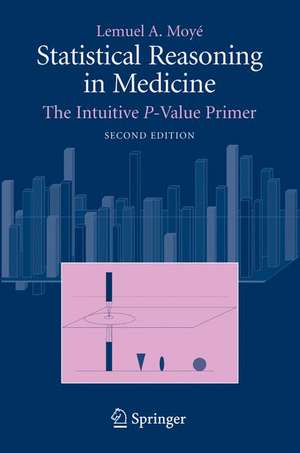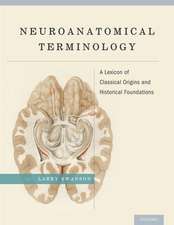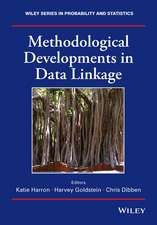Statistical Reasoning in Medicine: The Intuitive P-Value Primer
Autor Lemuel A. Moyéen Limba Engleză Paperback – 16 aug 2006
The successful Statistical Reasoning in Medicine: The Intuitive P-value Primer, with its novel emphasis on patient and community protection, illustrated the correct use of statistics in health care research for healthcare workers. Through clear explanations and examples, this book provided the non-mathematician with a foundation for understanding the underlying statistical reasoning process in clinical research, the core principles of research design, and the correct use of statistical inference and p-values.
The P-Value Primer 2nd Edition levels the learning curve of statistics for health care researchers by further de-emphasizing mathematical and computational devices, bringing the principles of statistical reasoning closer to the uninitiated. Adding to the updated discussions of research design, hypothesis testing, regression analysis, and Bayes procedures, are new discussions of absolute and relative risk, as well as a lucid description of the number needed to treat (NNT). The multiple analysis issue is clearly defined, and a new description of the correct use and interpretation of combined endpoints in health care research is offered in an easily digestible format.
The P-value Primer 2nd Edition demolishes other obstacles that have impeded a clear understanding of the application of statistics in medicine. The intertwined roles of epidemiology and biostatistics are depicted. In addition to a description of the non-technical history of statistics, a new discussion describes the active cultural forces that have historically argued against the use of probability and statistics, placing the current applications and controversies involving p-values in context. New illustrations of the difficulties physicians and health care providers face in research are offered, and the differences between research skills and statistical skills are distinguished. New discussion describing the process of scientific reasoning, p-values, and the law is included. All of this nonstandard content, so essential for a well rounded perspective on the modern use of statistics in medicine, makes this volume unique among introductory statistics books.
New figures, conversation, and illustrations fortify each chapter. In addition, three new appendices have been added on the normal distribution, sample size computations, and new requirements for the use of statistics in the courtroom.
Preț: 390.25 lei
Nou
Puncte Express: 585
Preț estimativ în valută:
74.69€ • 80.63$ • 62.63£
74.69€ • 80.63$ • 62.63£
Carte tipărită la comandă
Livrare economică 18 aprilie-02 mai
Preluare comenzi: 021 569.72.76
Specificații
ISBN-13: 9780387329130
ISBN-10: 0387329137
Pagini: 301
Ilustrații: XX, 302 p. 46 illus.
Dimensiuni: 155 x 235 x 15 mm
Greutate: 0.47 kg
Ediția:2nd ed. 2006
Editura: Springer
Colecția Springer
Locul publicării:New York, NY, United States
ISBN-10: 0387329137
Pagini: 301
Ilustrații: XX, 302 p. 46 illus.
Dimensiuni: 155 x 235 x 15 mm
Greutate: 0.47 kg
Ediția:2nd ed. 2006
Editura: Springer
Colecția Springer
Locul publicării:New York, NY, United States
Public țintă
Professional/practitionerCuprins
Prologue.- The Basis of Statistical Reasoning in Medicine.- Search Versus Research.- A Hypothesis-Testing Primer.- Mistaken Identity: P-values in Epidemiology.- Shrine Worship.- P-values, Power, and Efficacy.- Scientific Reasoning, P-values, and the Court.- One-Sided Versus Two-Sided Testing.- Multiple Testing and Combined Endpoints.- Subgroup Analyses.- P-values and Regression Analyses.- Bayesian Analysis: Posterior P-values.
Recenzii
From the reviews of the second edition:
"This book presents statisitical principles for health-care workers without previous statsitical training beyond an introductory course in applied statistics. The exposition uses nonmathematical language and rich examples in explaining the correct use of many statistical methods, interpretations of p values, and the results of clinical studies. Although intended for health-care workers, this book will help nonstatisticians better understand statistics in medical research, especially those looking to intepret statistical findings more scientifically." (Peng Huang, The American Statistician, Vol. 61, No. 3, 2007)
"This book’s purpose is a nonmathematical access on statistical inference and p-values in health care research as well as on core principles of research design. It is organized in 12 chapters and 3 appendices. Each chapter is accompanied by a conclusion section, a reference list and numerous entertaining real and hypothetical examples. … In summary, this text book retains the intended nonmathematical readership and provides an entertaining introduction to the principles of statistical reasoning." (Iris Burkholder, Zentralblatt MATH, Vol. 1111 (8), 2007)
"This book presents statisitical principles for health-care workers without previous statsitical training beyond an introductory course in applied statistics. The exposition uses nonmathematical language and rich examples in explaining the correct use of many statistical methods, interpretations of p values, and the results of clinical studies. Although intended for health-care workers, this book will help nonstatisticians better understand statistics in medical research, especially those looking to intepret statistical findings more scientifically." (Peng Huang, The American Statistician, Vol. 61, No. 3, 2007)
"This book’s purpose is a nonmathematical access on statistical inference and p-values in health care research as well as on core principles of research design. It is organized in 12 chapters and 3 appendices. Each chapter is accompanied by a conclusion section, a reference list and numerous entertaining real and hypothetical examples. … In summary, this text book retains the intended nonmathematical readership and provides an entertaining introduction to the principles of statistical reasoning." (Iris Burkholder, Zentralblatt MATH, Vol. 1111 (8), 2007)
Textul de pe ultima copertă
Lowers the Learning Curve for Physicians and Researchers!
The successful Statistical Reasoning in Medicine: The Intuitive P-value Primer, with its novel emphasis on patient and community protection, illustrated the correct use of statistics in health care research for healthcare workers. Through clear explanations and examples, this book provided the non-mathematician with a foundation for understanding the underlying statistical reasoning process in clinical research, the core principles of research design, and the correct use of statistical inference and p-values.
The P-Value Primer 2nd Edition levels the learning curve of statistics for health care researchers by further de-emphasizing mathematical and computational devices, bringing the principles of statistical reasoning closer to the uninitiated. Adding to the updated discussions of research design, hypothesis testing, regression analysis, and Bayes procedures, are new discussions of absolute and relative risk, as well as a lucid description of the number needed to treat (NNT). The multiple analysis issue is clearly defined, and a new description of the correct use and interpretation of combined endpoints in health care research is offered in an easily digestible format.
The P-value Primer 2nd Edition demolishes other obstacles that have impeded a clear understanding of the application of statistics in medicine. The intertwined roles of epidemiology and biostatistics are depicted. In addition to a description of the non-technical history of statistics, a new discussion describes the active cultural forces that have historically argued against the use of probability and statistics, placing the current applications and controversies involving p-values in context. New illustrations of the difficulties physicians and health care providers face in research are offered, and the differences between research skills and statistical skills are distinguished. New discussion describing the process of scientific reasoning, p-values, and the law is included. All of this nonstandard content, so essential for a well rounded perspective on the modern use of statistics in medicine, makes this volume unique among introductory statistics books.
New figures, conversation, and illustrations fortify each chapter. In addition, three new appendices have been added on the normal distribution, sample size computations, and new requirements for the use of statistics in the courtroom.
Dr. Lemuel A. Moyé, M.D., Ph.D., is Professor of Biostatistics and the University of Texas School of Public Health, and is a licensed physician for twenty-five years in Indiana and Texas. Dr. Moyé has served as a clinical trial consultant for many pharmaceutical companies, and, in addition, has worked for the Federal Food and Drug Administration, serving for six years on an advisory committee and providing guidance to the FDA on the approval of drugs and devices. He has written six textbooks in the application of statistics to public health research.
The successful Statistical Reasoning in Medicine: The Intuitive P-value Primer, with its novel emphasis on patient and community protection, illustrated the correct use of statistics in health care research for healthcare workers. Through clear explanations and examples, this book provided the non-mathematician with a foundation for understanding the underlying statistical reasoning process in clinical research, the core principles of research design, and the correct use of statistical inference and p-values.
The P-Value Primer 2nd Edition levels the learning curve of statistics for health care researchers by further de-emphasizing mathematical and computational devices, bringing the principles of statistical reasoning closer to the uninitiated. Adding to the updated discussions of research design, hypothesis testing, regression analysis, and Bayes procedures, are new discussions of absolute and relative risk, as well as a lucid description of the number needed to treat (NNT). The multiple analysis issue is clearly defined, and a new description of the correct use and interpretation of combined endpoints in health care research is offered in an easily digestible format.
The P-value Primer 2nd Edition demolishes other obstacles that have impeded a clear understanding of the application of statistics in medicine. The intertwined roles of epidemiology and biostatistics are depicted. In addition to a description of the non-technical history of statistics, a new discussion describes the active cultural forces that have historically argued against the use of probability and statistics, placing the current applications and controversies involving p-values in context. New illustrations of the difficulties physicians and health care providers face in research are offered, and the differences between research skills and statistical skills are distinguished. New discussion describing the process of scientific reasoning, p-values, and the law is included. All of this nonstandard content, so essential for a well rounded perspective on the modern use of statistics in medicine, makes this volume unique among introductory statistics books.
New figures, conversation, and illustrations fortify each chapter. In addition, three new appendices have been added on the normal distribution, sample size computations, and new requirements for the use of statistics in the courtroom.
Dr. Lemuel A. Moyé, M.D., Ph.D., is Professor of Biostatistics and the University of Texas School of Public Health, and is a licensed physician for twenty-five years in Indiana and Texas. Dr. Moyé has served as a clinical trial consultant for many pharmaceutical companies, and, in addition, has worked for the Federal Food and Drug Administration, serving for six years on an advisory committee and providing guidance to the FDA on the approval of drugs and devices. He has written six textbooks in the application of statistics to public health research.
Caracteristici
Offers updated material















